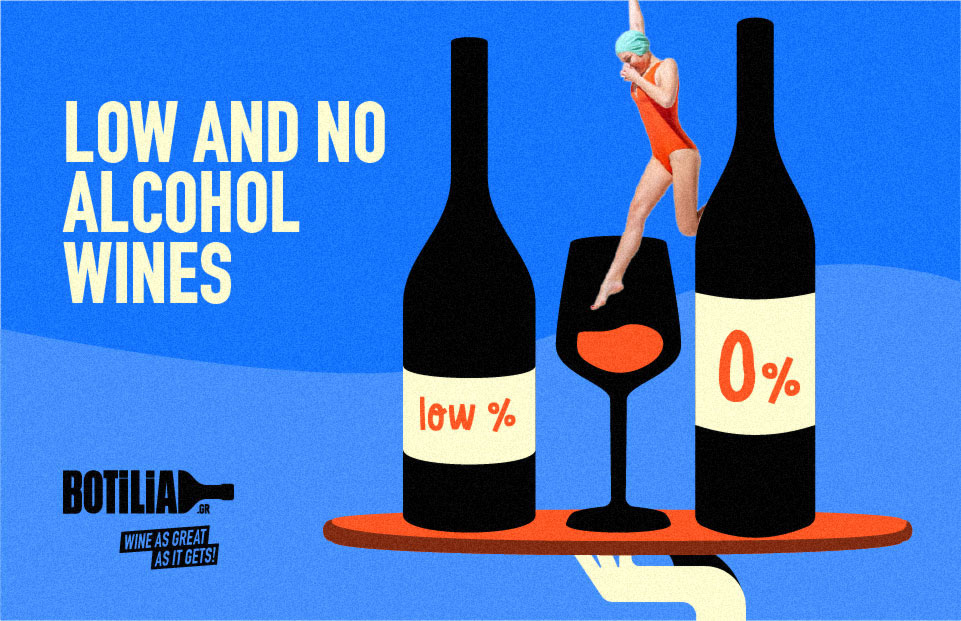LOW OR NO ALCOHOL WINES!

Wines with zero or low alcohol! It’s a fact and it doesn’t seem to be just a passing trend. The wine world is undergoing a true transformation, and on restaurant wine lists, store shelves, and across social media, so-called low or zero-alcohol wines internationally known as NoLo wines (No & Low alcohol) are appearing more and more frequently.
A growing number of consumers are turning to this category, driven by their evolving attitudes toward health and lifestyle. Cultural and religious reasons also play a role, as do movements like Dry January and Sober October, which encourage people to stay sober for an entire month. The conclusion is often the same: “If I can’t enjoy my favorite wine, why not try an alcohol-free version of it?”
Low and alcohol-free wines offer the pleasure of taste while aligning with a healthier, more modern lifestyle. And while alcohol may be absent, the benefits of wine consumption remain unchanged. For example, dealcoholized red wine still contains polyphenols, which are scientifically proven to support heart health and blood circulation.
A Brief Historical Perspective
Although alcohol-free wines are a relatively recent innovation, the idea of low-alcohol wine isn’t as new as we might think. As far back as antiquity, Greeks and Romans diluted must with water and repressed fresh grape pomace to produce wines low in sugar and alcohol often intended for slaves. This practice didn’t remove alcohol entirely but significantly reduced its content, making the wine milder and more socially acceptable, since intoxication was frowned upon outside of ritual events like Dionysian festivals.
Today, the philosophy behind low and alcohol-free wines returns with a different meaning not out of necessity, but as a conscious choice.
One of the most magical coincidences in wine history is that, in the early 20th century, two men with the exact same name, Carl Jung, explored the role of alcohol in wine from entirely different perspectives. One, a psychiatrist and founder of analytical psychology, studied the spiritual dimension of addiction and indirectly contributed to the creation of Alcoholics Anonymous. The other, a winemaker from Rheingau, wondered whether wine could be just as enjoyable without alcohol and developed the first method of dealcoholization.
They never met, but they shared a common question:
“What happens when you remove alcohol from wine?” , both in the mind and in the glass.
What Exactly Is It?
The NoLo category is divided into two main groups:
-
Alcohol-free wine: contains up to 0.5% alcohol. Labels must state “dealcoholised wine” or “alcohol-free wine.”
-
Low-alcohol wine: contains between 0.5% and 8.5% alcohol. Labels must state “partly dealcoholized wine” or “low alcohol wine.”
Both types are made exclusively from grapes, must, or wine, using methods that comply with European standards. Their production follows strict regulations to preserve quality and authenticity. Only specific additives and technical processes are permitted, and labels must clearly indicate which category the wine belongs to—so consumers know exactly what they’re buying.
How Are They Made?
Let’s agree not to include the ancient Greek method of dilution with water in this field!
The first successful attempt to remove alcohol from wine was in 1907, when German oenologist Carl Jung developed vacuum distillation. Since then, technology has advanced rapidly, and the following methods are now widely used:
-
Vacuum distillation: lowers the boiling point of alcohol by using vacuum pressure, allowing it to evaporate at low temperatures without altering aromas and flavors.
-
Reverse osmosis: wine passes through an ultra-fine (and expensive!) membrane that separates and removes the alcohol.
-
Spinning cone column: uses centrifugal force to separate wine components. A combination of evaporation and temperature-based separation removes alcohol while preserving flavor.
-
Fermentation adjustment: used only for low-alcohol wines, where fermentation is shortened so alcohol levels remain low from the start. This method is less common, as it tends to produce simpler wines.
Time to Try Them Yourself!
Low and alcohol-free wines are a great choice for those who value flavor as much as the social and cultural dimensions of wine consumption. Production is growing rapidly in many wine-producing countries, with renowned winemakers experimenting with techniques and grape varieties that preserve both the wine’s character and the producer’s identity.
Among the most intriguing NoLo options:
-
Dr. Lo Dry Alcohol Free Riesling by Dr. Loosen: mineral-driven and refreshingly aromatic, thanks to gentle vacuum distillation that retains the Mosel’s signature character.
-
Noughty Rosé by Thomson and Scott: made from Chenin Blanc and Pinotage from the Western Cape, offering fruity intensity and body, enhanced by aging on fine lees and vacuum distillation.
-
Now Low Alcohol 2024 by the brilliant team at No Ordinary Wines: a clever low-alcohol Greek wine from Roditis and Moschofilero, with aromas and flavors elevated by full use of grape derivatives drawing inspiration from ancient Greek methods.
-
Noughty Rouge by Thomson and Scott: Syrah from South Africa, combining aromatic depth and structure, aged in barrels and dealcoholized via spinning cone.
-
Noughty Blanc by Thomson and Scott: a blend of Chenin Blanc and Chardonnay, organic and multidimensional, with aromas preserved through low-temperature fermentation.
Each one is worth tasting for its unique character and technical approach. You can start now!
Christina Tsogka


